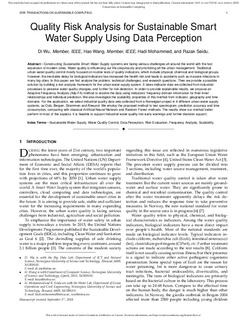| dc.contributor.author | Wu, Di | |
| dc.contributor.author | Wang, Hao | |
| dc.contributor.author | Mohammed, Hadi | |
| dc.contributor.author | Seidu, Razak | |
| dc.date.accessioned | 2019-08-28T11:52:49Z | |
| dc.date.available | 2019-08-28T11:52:49Z | |
| dc.date.created | 2019-08-27T11:03:07Z | |
| dc.date.issued | 2019 | |
| dc.identifier.issn | 2377-3782 | |
| dc.identifier.uri | http://hdl.handle.net/11250/2611419 | |
| dc.description.abstract | Constructing Sustainable Smart Water Supply systems are facing serious challenges all around the world with fast expansion of modern cities. Water quality is influencing our life ubiquitously. Traditional urban water quality control mostly focused on routine tests of quality indicators, which include physical, chemical and biological groups. However, inevitable delay for biological indicators has increased the health risk. In this paper, we first analyze the challenges and research questions. Then we provide a solution by building a risk analysis framework for urban water supply system. It takes indicators to perceive water quality changes, and further for risk detection. We propose an Adaptive Frequency Analysis (Adp-FA) method to resolve the data using indicators' frequency domain for their inner relationships and predictions. We also investigate the scalability properties of this method from indicator, geography and time domains. For the application, we select industrial quality data sets collected from 4 different Norwegian urban water supply systems, as Oslo, Bergen, Strommen and Aalesund. We test spectrogram, prediction accuracy and time consumption, compare with classical Artificial Neural Network and Random Forest methods. The results show our method better perform in most of the aspects. It is feasible to support industrial water quality risk early warnings. | nb_NO |
| dc.language.iso | eng | nb_NO |
| dc.publisher | Institute of Electrical and Electronics Engineers (IEEE) | nb_NO |
| dc.rights | Navngivelse 4.0 Internasjonal | * |
| dc.rights.uri | http://creativecommons.org/licenses/by/4.0/deed.no | * |
| dc.title | Quality Risk Analysis for Sustainable Smart Water Supply Using Data Perception | nb_NO |
| dc.type | Journal article | nb_NO |
| dc.type | Peer reviewed | nb_NO |
| dc.description.version | publishedVersion | nb_NO |
| dc.source.journal | IEEE Transactions on Sustainable Computing | nb_NO |
| dc.identifier.doi | 10.1109/TSUSC.2019.2929953 | |
| dc.identifier.cristin | 1719020 | |
| dc.description.localcode | This work is licensed under a Creative Commons Attribution 4.0 License. For more information, see https://creativecommons.org/licenses/by/4.0/. | nb_NO |
| cristin.unitcode | 194,63,55,0 | |
| cristin.unitcode | 194,63,10,0 | |
| cristin.unitcode | 194,64,93,0 | |
| cristin.unitname | Institutt for IKT og realfag | |
| cristin.unitname | Institutt for datateknologi og informatikk | |
| cristin.unitname | Institutt for havromsoperasjoner og byggteknikk | |
| cristin.ispublished | false | |
| cristin.fulltext | postprint | |
| cristin.qualitycode | 1 | |

